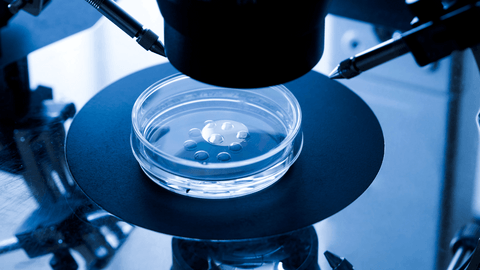What Is the Difference Between ICSI and IVF?
There are two types of In Vitro Fertilization treatment, which depends on the method used for egg insemination: traditional IVF and IVF with Intracytoplasmic Sperm Injection (ICSI).
The main difference between IVF and ICSI is that In Vitro Fertilization will help solve infertility problems such as endometriosis, fallopian tube blockage, or other cases when ICSI treatment will treat male infertility cases as oligozoospermia or asthenozoospermia.

If you have been trying to conceive for more than one year, contact our specialists to get the necessary information about fertility treatments.
What is IVF Treatment?
In-vitro fertilization is the most effective form of assisted reproductive technology. It is a complex series of procedures used to help with fertility or prevent genetic problems and assist with the conception of a child. The process of having an IVF cycle consists of getting mature eggs from the ovaries, fertilizing them with sperm in a lab, transferring the embryo to a uterus, and finally waiting for a time period.
What is ICSI Treatment?
The ICSI treatment process was introduced in the year 1992 to improve fertilization in couples. Intracytoplasmic Sperm Injection, a step ahead in the IVF treatment technique, has revolutionized male infertility in recent years.
Intracytoplasmic Sperm Injection (a complete form of ICSI) is a part of In-Vitro Fertilization (IVF). It is a procedure for people with severe male factor infertility.
The Process of IVF Treatment
The process of IVF consists of 5 steps:
- Ovarian Stimulation: During the first step, a woman takes medication so that healthy eggs are produced. Most months, women make only one egg, but with IVF, they stimulate 10-15 eggs to increase their chances of becoming pregnant.
- Egg Retrieval: The next step of IVF treatment involves the harvesting of eggs. Egg retrieval is done while a woman sleeps under a general anesthetic. Once completed, an embryologist examines the eggs under a microscope to count them.
- Fertilisation: The next thing that happens is the fertilization of eggs and sperm. The timing is crucial here. The eggs are retrieved, and then, after a few hours, they're fertilized with sperm. There are two ways to fertilize an egg: Conventional insemination or ICSI. In conventional insemination, the sperm is placed in a dish containing an egg to allow them to fertilize on their own. In ICSI, one sperm is injected into the cytoplasm of a fertilized egg using a needle.
- Blastocyst Culture: Once the sperm fertilizes the egg, it becomes an embryo. The embryo is then placed in a unique incubator by embryologist, where the embryo is provided with the proper condition to develop and grow. Adequate monitoring of the embryo is done for 5-6 days.
- Embryo Transfer: The final step is Embryo Transfer. Once the embryo develops to the blastocyst stage, it is implanted into the uterus using a small tube called Catheter. It usually takes place within 3-5 days after fertilisation. Once the embryo is transferred to the uterus, it is allowed to the implant, and a blood test is carried on after two weeks to measure the hormone HCG.
The Process of ICSI Treatment
The process of ICSI consists of 6 steps:
- Fertility Consultation: The consultation includes a discussion with the fertility specialist, followed by a thorough medical examination. An embryologist will explain the options available to address issues related to sperm.
- Stimulation:
During this stage, a woman needs to visit on day two or three of her menstrual cycle, when hormonal investigations are done along with an ultrasound. The ovaries are stimulated with medication to promote the growth of follicles containing the eggs; this process can last for eight to 12 days. The response of the ovaries will be screened through ultrasounds and blood investigations at regular intervals.
- Egg Collection:
An injection is given to help with its final maturation after eight to 12 days, and it is then removed. The patient will visit the clinic for the egg retrieval process, performed 34-36 hours after administering the trigger.
- Sperm Collection:
An embryologist processes a sperm sample that the male partner provided. If the male partner has no sperm in his epididymis or testicles, the embryologist can extract sperm from those organs.
- Embryo Transfer:
After the embryos are developed, it will be injected into the uterus to implant and impregnate the woman. A thin, flexible needle is used to inject them into the uterus.
- After Transfer: After the embryo transfer, a woman is given medicine to help the embryo implant in the uterus. After a few weeks, pregnancy is confirmed by taking pregnancy tests.
When is IVF Recommended?
IVF treatment is recommended for women who suffer from infertility issues. There are a variety of problems that women could have that prevent them from conceiving, ranging from ovulation disorders to hormonal problems to cysts in the ovaries to endometriosis and blocked fallopian tubes.
In vitro fertilization has proven to be the most successful fertility treatment, and its popularity is more significant than all other fertility treatments. This is because IVF can help patients with any fertility problem to have a baby.
When is ICSI Recommended?
In general, ICSI treatmet is recommended in case of male factor fertility. The doctor can recommend the procedure of ICSI couples in the following cases:
- In a case of a low count sperm;
- In a case of failed vasectomy reversal;
- In a case of difficulties with erection and ejaculation;
- In a case of poor morphology or poor motility.
References:

